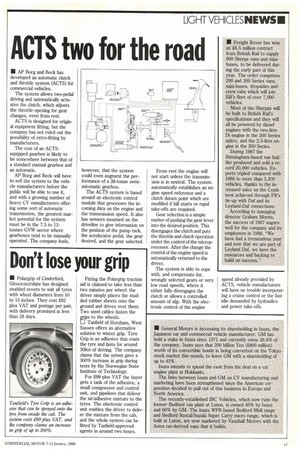ACTS two for the road
Page 19

If you've noticed an error in this article please click here to report it so we can fix it.
• AP Borg and Beck has developed an automatic clutch and throttle system (ACTS) for commercial vehicles.
The system allows two-pedal driving and automatically actuates the clutch, which adjusts the throttle opening for gear changes, even from rest.
ACTS is designed for original equipment fitting, but the company has not ruled out the possibility of retro-fitting by manufacturers.
The cost of an ACTSequipped gearbox is likely to be somewhere between that of a standard manual gearbox and an automatic.
AP Borg and Beck will have to sell the system to the vehicle manufacturers before the public will be able to use it, and with a growing number of heavy CV manufacturers offering some sort of automatic transmission, the greatest market potential for the system must be in the 7.5 to 12tonnes GVW sector where gearboxes tend to be manually operated. The company feels, however, that the system could even augment the performance of a 38-tonne semiautomatic gearbox.
The ACTS system is based around an electronic control module that processes the incoming data on the engine and the transmission speed. It also has sensors mounted on the driveline to give information on the position of the pump rack, the accelerator pedal, the gear desired, and the gear selected. From rest the engine will not start unless the transmission is in neutral. The system automatically establishes an engine speed reference and a clutch datum point which are modified if hill starts or rapid take-offs are required.
Gear selection is a simple matter of pushing the gear lever into the desired position. This disengages the clutch and puts the throttle and clutch operation under the control of the microprocessor. After the change the control of the engine speed is automatically returned to the driver.
The system is able to cope with, and compensate for, wrongly selected gears or very low road speeds, where it either fully disengages the clutch or allows a controlled amount of slip. With the electronic control of the engine speed already provided by ACTS, vehicle manufacturers will have no trouble incorporating a cruise control or the fast idle demanded by hydraulics and power take-offs.
































































